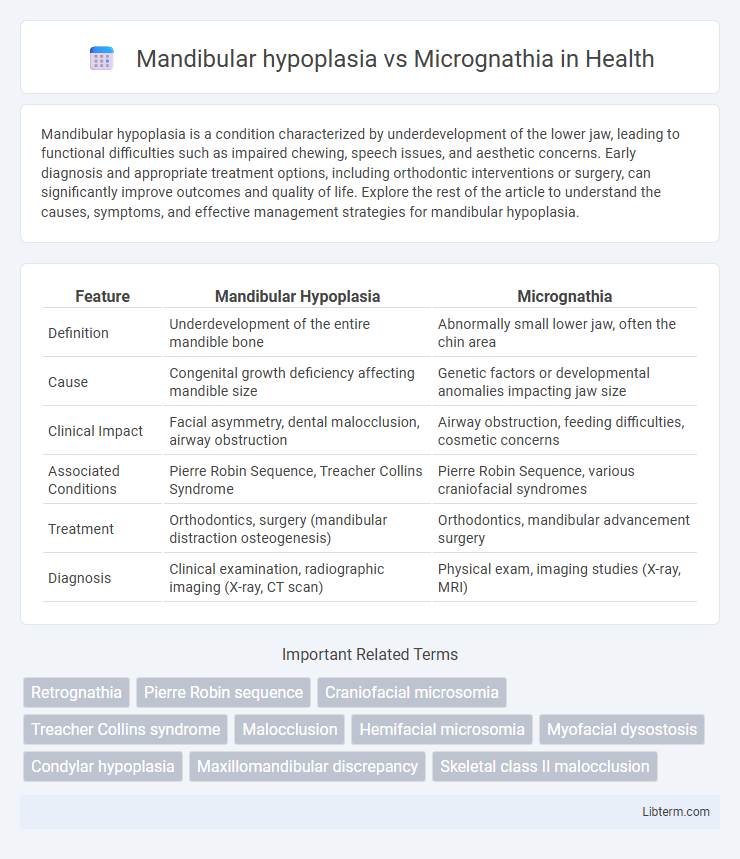Mandibular hypoplasia is a condition characterized by underdevelopment of the lower jaw, leading to functional difficulties such as impaired chewing, speech issues, and aesthetic concerns. Early diagnosis and appropriate treatment options, including orthodontic interventions or surgery, can significantly improve outcomes and quality of life. Explore the rest of the article to understand the causes, symptoms, and effective management strategies for mandibular hypoplasia.
Table of Comparison
| Feature | Mandibular Hypoplasia | Micrognathia |
|---|---|---|
| Definition | Underdevelopment of the entire mandible bone | Abnormally small lower jaw, often the chin area |
| Cause | Congenital growth deficiency affecting mandible size | Genetic factors or developmental anomalies impacting jaw size |
| Clinical Impact | Facial asymmetry, dental malocclusion, airway obstruction | Airway obstruction, feeding difficulties, cosmetic concerns |
| Associated Conditions | Pierre Robin Sequence, Treacher Collins Syndrome | Pierre Robin Sequence, various craniofacial syndromes |
| Treatment | Orthodontics, surgery (mandibular distraction osteogenesis) | Orthodontics, mandibular advancement surgery |
| Diagnosis | Clinical examination, radiographic imaging (X-ray, CT scan) | Physical exam, imaging studies (X-ray, MRI) |
Understanding Mandibular Hypoplasia
Mandibular hypoplasia involves underdevelopment of the lower jawbone, leading to a smaller and often asymmetrical mandible that can affect facial structure and function. This condition may result from genetic factors, congenital syndromes like Pierre Robin sequence, or environmental influences during fetal development. Distinct from micrognathia, which specifically refers to a small jaw size regardless of shape, mandibular hypoplasia encompasses both size reduction and deformity in jaw growth patterns.
Defining Micrognathia
Micrognathia is a condition characterized by an abnormally small lower jaw (mandible), often resulting in dental misalignment and breathing difficulties. Mandibular hypoplasia refers to the underdevelopment or incomplete growth of the mandible, which can cause facial asymmetry and functional impairment. While both involve mandibular size reduction, micrognathia specifically denotes a markedly small jaw that may cause more pronounced airway obstruction.
Key Differences Between Mandibular Hypoplasia and Micrognathia
Mandibular hypoplasia is characterized by underdevelopment or incomplete growth of the lower jawbone, leading to a shorter and smaller mandible, often associated with congenital syndromes such as Pierre Robin sequence or Treacher Collins syndrome. Micrognathia specifically denotes an abnormally small jaw, particularly the mandible, which may be a feature of mandibular hypoplasia but can also occur independently, causing airway obstruction and feeding difficulties in newborns. The key difference lies in mandibular hypoplasia referring to developmental deficiency of the mandible itself, while micrognathia describes the clinical presentation of a small jaw regardless of the underlying cause.
Causes and Risk Factors
Mandibular hypoplasia results from incomplete development of the lower jaw during fetal growth, often linked to genetic mutations, syndromes like Pierre Robin sequence, and environmental factors such as maternal smoking or drug exposure. Micrognathia specifically involves an abnormally small jaw and can be caused by chromosomal abnormalities, neuromuscular disorders, or intrauterine constraints restricting mandibular growth. Both conditions share risk factors including genetic predisposition, prenatal infections, and teratogenic exposures, but mandibular hypoplasia emphasizes developmental arrest while micrognathia highlights size reduction from diverse etiologies.
Clinical Features and Diagnosis
Mandibular hypoplasia presents with underdevelopment of the mandible leading to facial asymmetry and difficulties in mastication and speech, whereas micrognathia is characterized by an abnormally small jaw often causing airway obstruction and feeding problems in newborns. Clinical features of mandibular hypoplasia include a retruded lower jaw and malocclusion, while micrognathia is identified by a receding chin and glossoptosis. Diagnosis relies on clinical examination complemented by imaging techniques such as cephalometric radiographs or 3D CT scans to assess jaw morphology and severity.
Impact on Facial Appearance and Function
Mandibular hypoplasia involves underdevelopment of the entire mandible, leading to a noticeably smaller lower jaw that can cause facial asymmetry and malocclusion, affecting chewing and speech. Micrognathia specifically refers to a disproportionately small mandible, often causing a receding chin and potential airway obstruction, which can impact breathing and feeding, especially in infants. Both conditions significantly alter facial aesthetics and functional capabilities, often necessitating orthodontic or surgical interventions for optimal outcomes.
Associated Syndromes and Conditions
Mandibular hypoplasia often presents in syndromes such as Pierre Robin sequence, Treacher Collins syndrome, and hemifacial microsomia, characterized by underdeveloped jaw structures impacting airway and facial symmetry. Micrognathia, commonly associated with Stickler syndrome, 22q11.2 deletion syndrome, and congenital conditions like trisomy 18, involves a smaller-than-normal lower jaw leading to feeding difficulties and respiratory issues. Differentiating these conditions through associated syndromes aids in targeted genetic testing and multidisciplinary management approaches.
Treatment Options and Management Strategies
Mandibular hypoplasia treatment often involves distraction osteogenesis to gradually lengthen the jaw bone, improving airway patency and facial symmetry, often combined with orthodontic therapy to correct malocclusion. Micrognathia management may require mandibular advancement surgery, such as bilateral sagittal split osteotomy, especially in severe cases causing obstructive sleep apnea or feeding difficulties in infants. Both conditions benefit from multidisciplinary care including speech therapy, nutritional support, and continuous monitoring for airway obstruction or dental complications.
Prognosis and Long-term Outcomes
Mandibular hypoplasia and micrognathia both involve underdevelopment of the lower jaw, but mandibular hypoplasia typically indicates a more generalized reduction affecting jaw size and shape, often linked to syndromes like Pierre Robin sequence. Prognosis depends on severity and associated conditions, with mandibular hypoplasia potentially leading to airway obstruction, feeding difficulties, and the need for early surgical intervention, while isolated micrognathia may resolve or improve with growth. Long-term outcomes vary, ranging from normal function after treatment to persistent challenges with breathing, speech, and dental alignment.
Prevention and Early Intervention
Mandibular hypoplasia and micrognathia require early detection through prenatal ultrasound and genetic screening to guide timely intervention. Implementing airway management strategies and multidisciplinary care in neonates can prevent respiratory complications associated with these craniofacial anomalies. Early orthopedic and surgical treatments, such as mandibular distraction osteogenesis, improve functional outcomes and reduce long-term morbidity.
Mandibular hypoplasia Infographic

 libterm.com
libterm.com